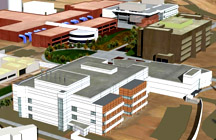
If claims of Sandia efficiency cause you to throttle laughter because of some bad past experience, rebuild your faith by watching the amazing progress of the MESA project, which has now let out the contract for its final building, the Weapons Integration Facility (WIF), the linchpin of the half-billion-dollar complex.
The project — which has required rerouting a major road around Area 1, putting in a complete set of new underground utilities, renovating the Microelectronics Development Laboratory (MDL), adding a microFab and microLab to fabricate and test compound semiconductors such as gallium arsenide as well as silicon devices, and adding communications links to the new computer and nanotechnology buildings — has proceeded on time and on budget. Though problems always dog large projects, this one seems to be proceeding as unstoppably as an ocean wave.
The $44 million construction contract for WIF was placed with Hensel Phelps Construction Co. on June 28. According to deputy project manager Bill Kitsos (10823), a notice to proceed went out on Sept. 8, and “we should be seeing heavy machinery this week digging the basement.” Physical completion is scheduled for May 2006.
The building has two components, classified and unclassified, with the exterior wall of the unclassified component forming the border of the classified area.
The structure — three stories within the fence and two stories without — will contain a next-generation VIEWS Corridor to allow weapons designers and microsystems engineers to simulate their designs through advanced computing before they build devices.
“I’ve got nothing against experimenters,” says MESA Program Director Don Cook (1900). “I was trained that way myself; I love to measure things precisely. But researchers get more out of life — they’re more productive — if they’re getting data to improve their understanding of their models.”
Devices, he says, have to work in intended but also unintended environments, and “you can’t test in all these areas, so you have to model and experiment atboundaries.” The data then obtained show not only how a device works but where, why, and how it might fail.
Put another way, says Philip Heermann (15230), to be productive, weapons and microsystems designers of the future must be able to understand the information in their computers. “They can’t hold it in their hands,” Phil says. “They have to have a means to look at it.” And they will have that means, he says, because the leading edge of ASC [Advanced Simulation and Computing] visualization will be located in WIF.
The orderly arrangement of new buildings bodes well for Sandia’s future, Don says. “In between the nano and the cogno [i.e., computers] is the micro,” he says, gesturing first to the north at the future location of the Sandia/Los Alamos Center for Integrated Nanotechnologies (CINT), now under construction along Eubank Blvd., then to the west at the new computer building known as JCEL (Joint Computational Engineering Lab), before gesturing at the near ground that will house the MESA center. MESA stands for Microsystems and Engineering Sciences Applications.
A 40-foot-wide pedestrian mall will stretch from the east end of the microLab/microFab to the other end of JCEL and eventually past the Steve Schiff auditorium, with trees, benches, and even a small waterfall whose active ingredient —water — will be reused a final time, after reclamation from Sandia’s microfabrication facility, before entering the Albuquerque sewer system.
Two new parking lots, doubling the current capacity of the IMRL lots, will be added, says MESA project manager Bill Jenkins (1920).
A “cafeteria” eventually will replace T-City, whose employees can expect to be moved into a more energy-efficient permanent space. No time schedule has yet been established.
Don, providing a tour of the area to the Lab News, was happy to be stopped by a construction worker who reminded him to wear a helmet near construction work (though Don was not technically in the construction area).
“We have the paperwork done and the buildings going up on schedule,” he said. “Barring some unforeseen event, by ’08 everything will be done.”
Three hundred seventy-four researchers will occupy the WIF facility when completed.
“WIF will fulfill the MESA vision by co-locating individuals from various organizations into integrated teams to work on microtechnology solutions,” says Bill Jenkins.